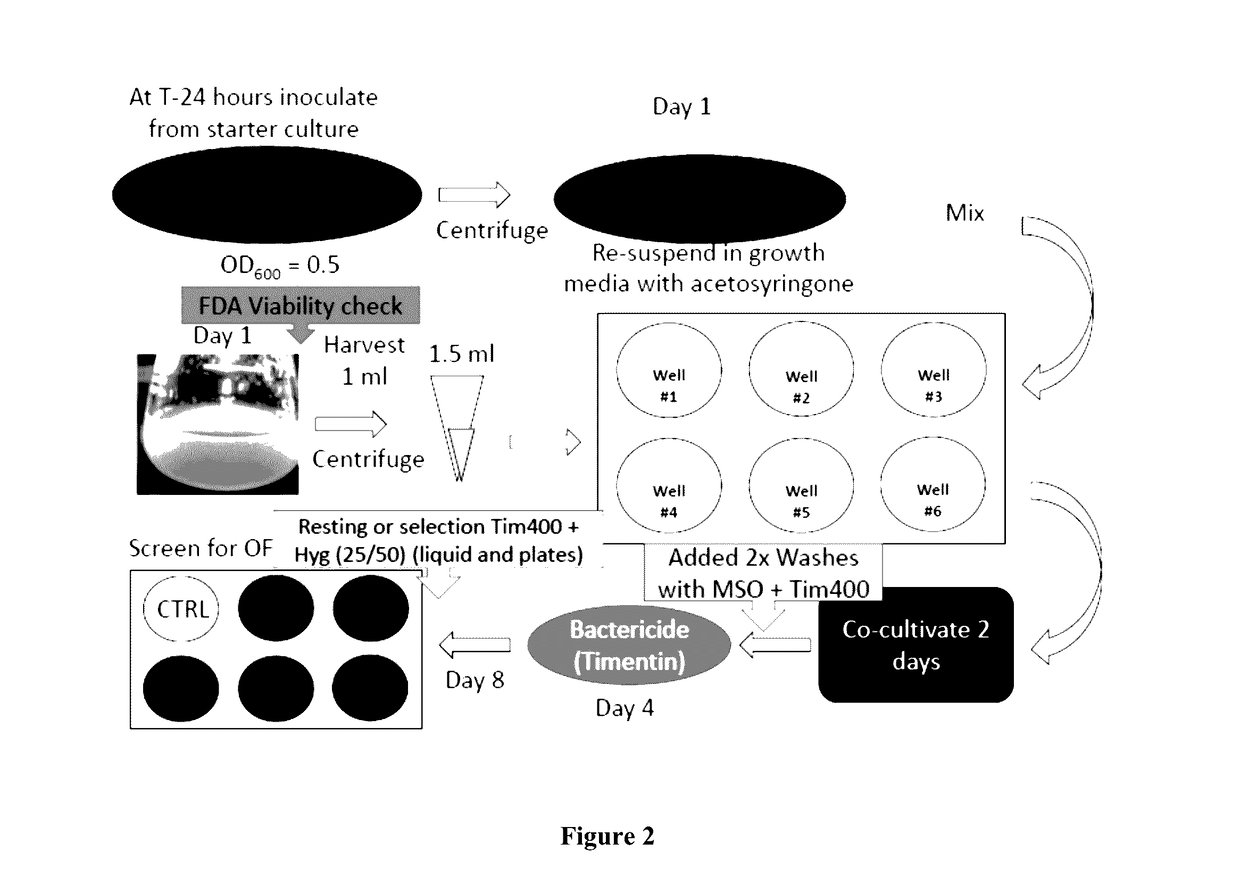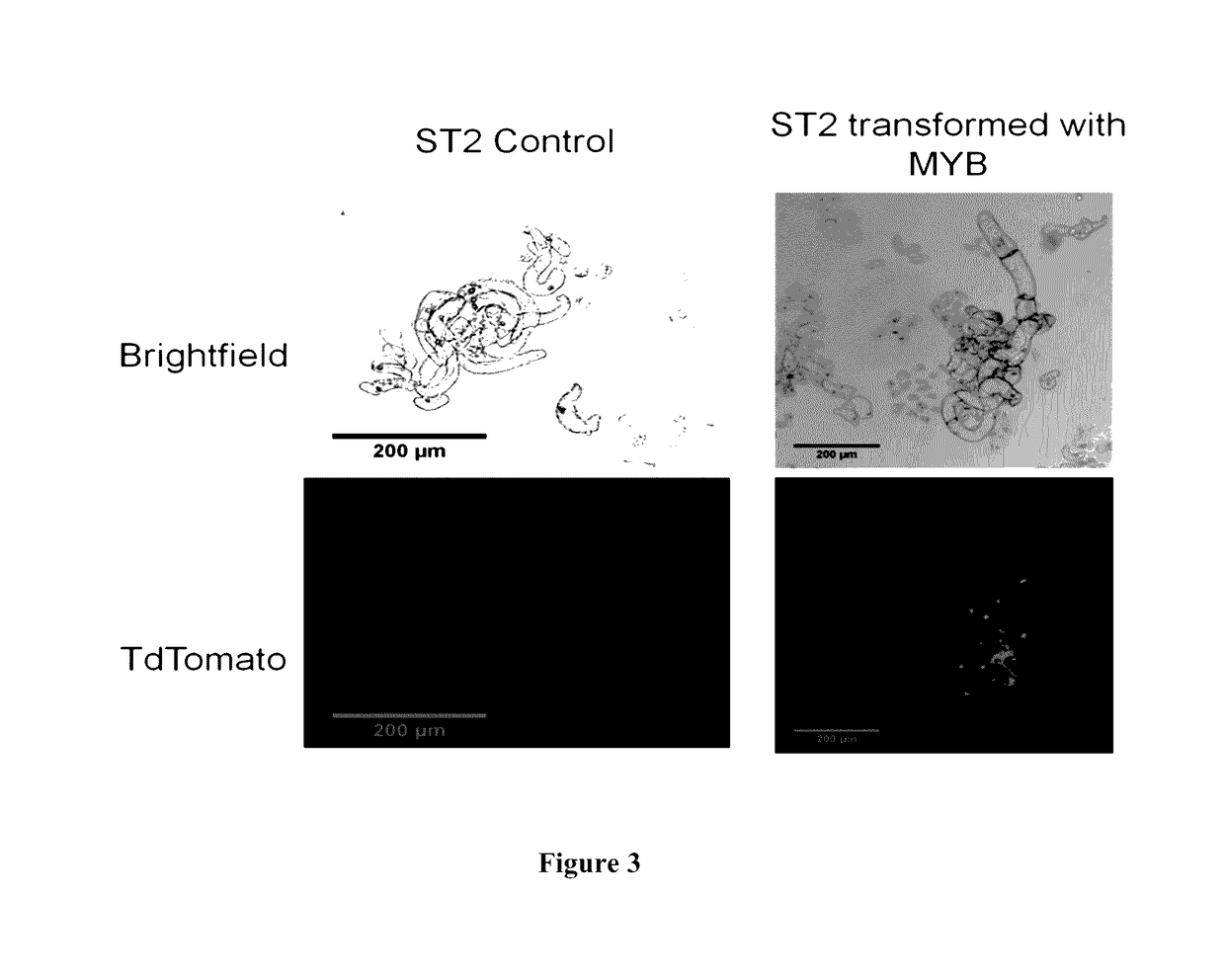Methods of plant transformation using transformable cell suspension culture and uses thereof
a technology of plant cell suspension and cell suspension, which is applied in the field of plant transformation using transformable cell suspension culture, can solve the problems of current available methods of plant genetic modification, plant cell transformation and plant generation therefrom, and are too slow
- Summary
- Abstract
- Description
- Claims
- Application Information
AI Technical Summary
Benefits of technology
Problems solved by technology
Method used
Image
Examples
example 1
nt of Switchgrass Transformable Cell Suspension Culture and Screening System for Rapid Assessment of Cell Wall Genes for Improved Biomass for Biofuel Production
[0083]Transformation and chemical characterization of plant cell wall characteristics for switchgrass is arduous and time consuming. An embodiment of the current invention provides transformable switchgrass cell culture lines with corresponding chemical fingerprinting to rapidly screen cell wall compositions in lines having modified genes.
[0084]Transgenic switchgrass plants having down-regulated lignin content, i.e. plants having down-regulated caffeic acid 3-O-methyltransferase (COMT) via inhibitor RNA or plants having overexpression of MYB4 transcription factor were used as donors for inflorescence meristem tissue to induce callus. COMT and MYB4 calluses were added to a liquid culture system to produce aggregate and non-aggregate cells to be evaluated by spectral and chemical analysis for cell wall properties.
[0085]Calluses...
example 2
timation
[0086]Organosolve-extracted switchgrass lignin was used as standard control. Excitation wavelength of 300 nm to 1000 nm was used and emissions collected at 350 nm to 1050 nm. Python script was written to assimilate data and placed into a single dataset which was processed in R and later Python.
Example 3—Genotypic Selection of Performer Line Switchgrass Clones for Efficiency in Agrobacterium-Mediated Transformation and In Vitro Culturing
[0087]Genotypes from the Performer line of switchgrass were run through a genotype pipeline to narrow down selected genotypes. Selection was based on higher transformation rates through Agrobacterium-mediated transformation as well as faster generational cycling time through tissue culture. Starting from one million seeds, 1198 that proliferated viable calli were re-cultured in vitro and cycled through regeneration with selection at each progression based on performance. Those selected for high efficiency through tissue culture were then re-cu...
example 4
g Plants and Suspension Cultures from Clone #605
[0155]Clone #605 obtained from the Performer Cultivar as described in Example 3 is hereinafter identified as P605. P605 plants recovered from tissue culture were maintained in the UT Racheff greenhouse in 3 gallon pots under 16 hour days. Explants for tissue cultures were taken from greenhouse grown tiller meristems, sterilized in 20% bleach, rinsed 3 times with sterile water. In a sterile laminar hood, washed tillers were split longitudinally with a scalpel blade and placed cut side down into Petri plates with MSB media. Plates were incubated for two weeks at room temperature in the dark to induce fresh inflorescences. After sufficient production, inflorescences were cut into 1 cm sections and placed onto callus induction MP media. Callus was sub-cultured each 2-3 weeks moving to fresh media and removing from culture any browning or dying tissues. Type 2 callus (white to slightly yellow, friable) was chosen exclusively for subculture....
PUM
| Property | Measurement | Unit |
|---|---|---|
| optical density | aaaaa | aaaaa |
| optical density | aaaaa | aaaaa |
| optical density | aaaaa | aaaaa |
Abstract
Description
Claims
Application Information
 Login to View More
Login to View More - R&D
- Intellectual Property
- Life Sciences
- Materials
- Tech Scout
- Unparalleled Data Quality
- Higher Quality Content
- 60% Fewer Hallucinations
Browse by: Latest US Patents, China's latest patents, Technical Efficacy Thesaurus, Application Domain, Technology Topic, Popular Technical Reports.
© 2025 PatSnap. All rights reserved.Legal|Privacy policy|Modern Slavery Act Transparency Statement|Sitemap|About US| Contact US: help@patsnap.com



